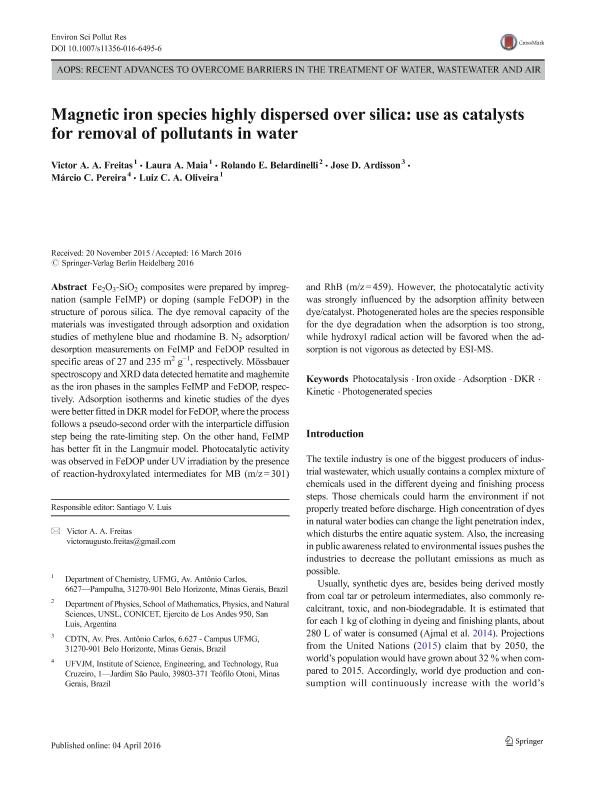Mostrar el registro sencillo del ítem
dc.contributor.author
Freitas, Victor A. A.
dc.contributor.author
Maia, Laura A.
dc.contributor.author
Belardinelli, Rolando Elio

dc.contributor.author
Ardisson, Jose D.
dc.contributor.author
Pereira, Márcio C.
dc.contributor.author
Oliveira, Luiz C. A.
dc.date.available
2018-09-21T15:56:51Z
dc.date.issued
2017-03
dc.identifier.citation
Freitas, Victor A. A.; Maia, Laura A.; Belardinelli, Rolando Elio; Ardisson, Jose D.; Pereira, Márcio C.; et al.; Magnetic iron species highly dispersed over silica: use as catalysts for removal of pollutants in water; Springer Heidelberg; Environmental Science and Pollution Research; 24; 7; 3-2017; 6114-6125
dc.identifier.issn
0944-1344
dc.identifier.uri
http://hdl.handle.net/11336/60564
dc.description.abstract
Fe2O3-SiO2 composites were prepared by impregnation (sample FeIMP) or doping (sample FeDOP) in the structure of porous silica. The dye removal capacity of the materials was investigated through adsorption and oxidation studies of methylene blue and rhodamine B. N2 adsorption/desorption measurements on FeIMP and FeDOP resulted in specific areas of 27 and 235 m2 g−1, respectively. Mössbauer spectroscopy and XRD data detected hematite and maghemite as the iron phases in the samples FeIMP and FeDOP, respectively. Adsorption isotherms and kinetic studies of the dyes were better fitted in DKR model for FeDOP, where the process follows a pseudo-second order with the interparticle diffusion step being the rate-limiting step. On the other hand, FeIMP has better fit in the Langmuir model. Photocatalytic activity was observed in FeDOP under UV irradiation by the presence of reaction-hydroxylated intermediates for MB (m/z = 301) and RhB (m/z = 459). However, the photocatalytic activity was strongly influenced by the adsorption affinity between dye/catalyst. Photogenerated holes are the species responsible for the dye degradation when the adsorption is too strong, while hydroxyl radical action will be favored when the adsorption is not vigorous as detected by ESI-MS.
dc.format
application/pdf
dc.language.iso
eng
dc.publisher
Springer Heidelberg

dc.rights
info:eu-repo/semantics/openAccess
dc.rights.uri
https://creativecommons.org/licenses/by-nc-sa/2.5/ar/
dc.subject
Adsorption
dc.subject
Dkr
dc.subject
Iron Oxide
dc.subject
Kinetic
dc.subject
Photocatalysis
dc.subject
Photogenerated Species
dc.subject.classification
Otras Ciencias Químicas

dc.subject.classification
Ciencias Químicas

dc.subject.classification
CIENCIAS NATURALES Y EXACTAS

dc.title
Magnetic iron species highly dispersed over silica: use as catalysts for removal of pollutants in water
dc.type
info:eu-repo/semantics/article
dc.type
info:ar-repo/semantics/artículo
dc.type
info:eu-repo/semantics/publishedVersion
dc.date.updated
2018-09-20T13:11:09Z
dc.identifier.eissn
1614-7499
dc.journal.volume
24
dc.journal.number
7
dc.journal.pagination
6114-6125
dc.journal.pais
Alemania

dc.journal.ciudad
Heidelberg
dc.description.fil
Fil: Freitas, Victor A. A.. Universidade Federal de Minas Gerais; Brasil
dc.description.fil
Fil: Maia, Laura A.. Universidade Federal de Minas Gerais; Brasil
dc.description.fil
Fil: Belardinelli, Rolando Elio. Universidad Nacional de San Luis. Facultad de Ciencias Físico Matemáticas y Naturales. Departamento de Física; Argentina. Consejo Nacional de Investigaciones Científicas y Técnicas. Centro Científico Tecnológico Conicet - San Luis. Instituto de Física Aplicada ; Argentina
dc.description.fil
Fil: Ardisson, Jose D.. Centro de Desenvolvimento da Tecnologia Nuclear; Brasil
dc.description.fil
Fil: Pereira, Márcio C.. Universidade Federal dos Vales do Jequitinhonha e Mucuri; Brasil
dc.description.fil
Fil: Oliveira, Luiz C. A.. Universidade Federal de Minas Gerais; Brasil
dc.journal.title
Environmental Science and Pollution Research

dc.relation.alternativeid
info:eu-repo/semantics/altIdentifier/doi/http://dx.doi.org/10.1007/s11356-016-6495-6
dc.relation.alternativeid
info:eu-repo/semantics/altIdentifier/url/https://link.springer.com/article/10.1007%2Fs11356-016-6495-6
Archivos asociados
